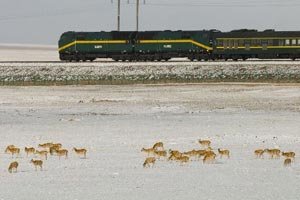After a decade of work, Tibet's environment shows new promise
Ten years ago, it was impossible to boil an egg in Tibet. The lack of oxygen in the air made the boiling point of water too low for proper cohesion of the yolk and egg white. But years of replanting forests and grasslands have restored oxygen into the air, and Tibetans now enjoy hard-boiled eggs every day.
The Chinese government has paid unprecedented attention to the ecological construction and environmental protection of Tibet over the past decade, pouring in 6.7 billion yuan (US$981 million) into the region as part of its China Western Development Plan. The policy covers 12 western provinces and regions of China, including Tibet, and aims to bring the areas in line with the more developed eastern China.
Qiangba Puncog, chairman of the Tibet Autonomous Region, said the region has benefited the most from the plan.
Forests and grasslands are spreading across Tibet like wildfire. Since 2004, the government has re-grassed 41.93 million mu (2.8 million hectares) and re-seeded 10.76 million mu (713,333 hectares) of forest in the region. Tibet also has the highest ration of nature reserves in China – one-third of its 1.2 million square kilometers are protected.
|
|
|
Female Tibetan antelopes stop to graze on their way to Zonag Lake for birth in this June 5, 2009 photo. Behind them, a train passes by on the Qinghai-Tibet Railway. |
Green economy has become popular on the Qinghai-Tibet Plateau. All projects in Tibet are strictly valued on environmental impact. Such protection has kept industry and development relatively low.
"Our industrial added value only accounts for 8 percent of our GDP," Qiangba Puncog said. But he noted they also have low carbon emissions.
The region even gave up its gold dust mining industry "to better protect Tibet's ecological environment," Qiangba Puncog said. The region no longer mines for iron sand, either.
Qiangba Puncog also defended the Qinghai-Tibet Railway, calling it an "ecological line." Completed in 2006, the railway was the first to connect the Tibetan plateau with inner China.
"Constructors put great efforts in environmental protection," Qiangba Puncog said. "Vegetations around the roadbed were first replanted and then restored. Routes are left for animals by building elevated tracks."
Qiangba Puncog said protecting Tibet's ecology benefits not just Tibet, but the entire country and continent, as well. Tibet's arctic climate makes it sensitive to climate change, which causes temperatures to rise before most other places in China and Asia. It also has a strong impact on the rest of the country's climate and environment. As the "water tower" of Asia, Tibet is the cradle of Asia's seven main freshwater rivers, including China's Yellow and Yangtze rivers.
The State Council approved 15 billion yuan (US$2.2 billion) last February to create a state ecological security shelter zone on the plateau by 2020.
"We will develop [our] green economy and make the sky bluer, the land greener and the water cleaner," Qiangba Puncog said.
(A version of this article was first published in Chinese on Chinanews.com.cn on January 7, 2010, and translated by Li Xiaohua.)
 0
0 








Go to Forum >>0 Comments